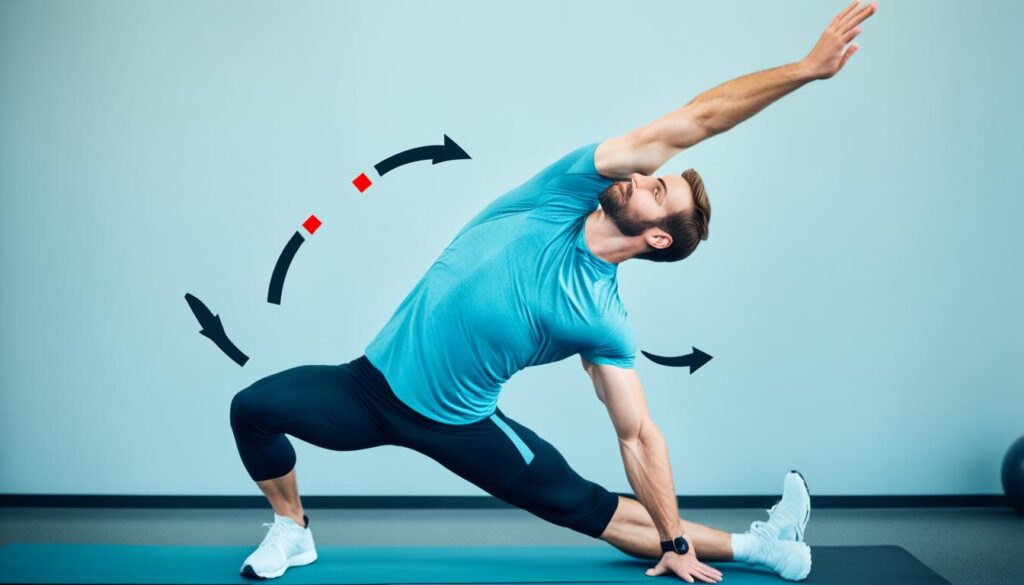Did you know a short 10-15 minutes of warm-up and cool-down can cut down injury risks? It can also make your workouts better. The Mayo Clinic says a good warm-up gets your heart ready, warms you up, and gets blood to your muscles. This reduces the chance of getting hurt or feeling sore after workouts. Cooling down is just as important. It helps bring your heart rate and blood pressure back to normal. This is very important for people who do a lot of endurance sports.
Warm-up and cool-down routines are key for safe exercising. They help your body adjust to starting and stopping exercise. If you skip these steps, you may get hurt more easily and your workouts might not go as well.
Key Takeaways
- Warm-up routines can prepare the cardiovascular system, boosting body temperature and blood flow.
- Cool-down exercises help revert heart rate and blood pressure to normal levels, aiding recovery.
- Both practices are low-risk and essential for injury prevention and efficient exercise preparation.
- Skipping warm-up and cool-down routines can increase the risk of injuries and decrease performance.
- Endurance athletes particularly benefit from structured cool-down routines.
Importance of Warm-Up and Cool-Down Routines
Warm-ups and cool-downs are key for joint safety and making you perform better. They involve low-intensity activities to get the body ready. This approach helps avoid injury and boosts your performance.
Warming up gets more blood to your muscles and raises their temperature. This makes your body ready for tougher activity. It prevents muscle injuries and improves your sports skills. Cooling down, on the other hand, brings your heart rate and blood pressure back to normal. It stops blood from pooling in your legs and eases heart stress.
Adding these routines to your exercise plan also protects your joints. Without them, you’re more likely to get hurt. Your muscles could get stiff, and recovery might take longer. So, it’s very important to make these routines a habit to reach your sports goals.
Physiological Benefits of Warming Up
A good warm-up routine is key for a great workout. It gets your body ready for exercise, helping to prevent injuries. This way, you can perform better, whether in sports or daily workouts.

Improved Blood Flow and Oxygen Efficiency
Starting with a warm-up increases blood flow. This means more oxygen goes to your muscles. It makes your muscles work better and last longer during exercise. Plus, it helps your body get the nutrients it needs to keep going strong.
Faster Muscle Contraction and Relaxation
Warming up makes your body warmer and your muscles can move faster. This is important for a top-notch performance and to avoid getting hurt. Adding stretches to your warm-up makes your muscles even readier for the workout.
Mental Preparation
Warm-ups aren’t just for your body. They also get your mind ready. Doing warm-ups specific to your activity helps you focus. Being mentally prepared helps you with skills and coordination, important for winning or just for a regular workout.
Effective Warm-Up Exercises
Warming up well is key to cutting injury risks and doing better in sports. Getting your body ready with the best methods really lowers the chance of getting hurt.
Dynamic Warm-Up Routines

Dynamic warm-ups get big muscle groups moving. They include slow walks or jogs. This boosts your heart rate and blood flow. It makes your muscles and joints ready for tougher exercises. It’s a top way to keep injuries away.
Activity-Specific Warm-Ups
Warm-ups made for specific sports help athletes get ready for their sport’s special needs and moves. Say, a basketball player works on dribbling and shooting. A runner does sprint drills. These focused warm-ups boost performance and reduce injuries. They’re vital for all athletes.
- Walking or Jogging Slowly
- Light Dribbling for Basketball
- Practice Shooting for Soccer
- Sprint Drills for Runners
Physiological Benefits of Cooling Down
Cool-down stretching routines are key for post-workout recovery. They help the body gently shift from high activity to rest. Engaging in these routines regulates blood pressure and heart rate. This reduces chances of feeling dizzy or lightheaded.
Gradual cool-down exercises improve blood circulation. This helps in removing metabolic waste from muscles, which cuts down on stiffness. The process not only relaxes you right away but also boosts flexibility and mobility over time.
Cool-down stretches do more than help the body recover. They also aid in mental relaxation. This allows athletes to think back on their training and get ready for what’s next. Such recovery practices keep athletes at their best and lower injury risks.
| Physiological Benefits | Outcome |
|---|---|
| Regulated Blood Pressure and Heart Rate | Prevents Lightheadedness |
| Improved Blood Flow | Efficient Waste Removal |
| Decreased Muscle Stiffness | Enhanced Flexibility |
| Mental Relaxation | Better Future Preparation |
Effective Cool-Down Exercises
After you finish exercising, it’s key to cool down properly. This helps bring your body back to a calm state. It’s good for your well-being. Cool-down exercises that focus on making your muscles more flexible are essential. They aid in recovery and get you ready for the next workout.
Gradual Pace Reduction
Beginning to slow down is a main part of cooling down. For instance, you might go from running to jogging, then walking. Slowing down gently helps your heart rate return to normal. It also stops blood from gathering in your legs, preventing dizziness or fainting.
Stretching for Flexibility and Recovery
After reducing your pace, you should start stretching. Stretching exercises make you more flexible and help your body recover. They reduce muscle soreness by lowering the amount of lactic acid. This prevents muscle cramps and stiffness.
| Cool-Down Exercise | Benefits | Duration |
|---|---|---|
| Slow Jog | Stabilizes heart rate | 5–10 minutes |
| Walking | Prevents blood pooling | 5–10 minutes |
| Static Stretching | Improves flexibility | 5–15 minutes |
Warm-Up and Cool-Down Routines for Specific Activities
Warm-up and cool-down routines are a must in any training plan. They match the needs of activities like running, swimming, and lifting weights. These routines help lower injury risk and boost performance, so athletes can give their all safely.
Running
Runners should start with easy jogging or fast walking. This prepares the muscles and heart for harder work. Cooling down with a gentle jog or walk, then stretching well, helps muscles recover and lessens soreness.

Swimming
Swimmers should warm up with slow strokes or dynamic moves like arm spins and leg kicks before getting in the water. After swimming, doing slower laps and stretches keeps you limber and helps avoid injuries. It’s key for staying in top shape.
Strength Training
Before lifting weights, do dynamic stretches such as lunges or arm circles. This gets your body ready. A good cool-down lowers the workout pace and adds stretches. It helps with muscle healing and cuts down on injury chances.
| Activity | Warm-Up | Cool-Down |
|---|---|---|
| Running | Light jog or brisk walk | Slow-paced jog or walk, static stretching |
| Swimming | Slow-paced strokes, arm circles | Reduced pace laps, static stretching |
| Strength Training | Dynamic stretches (lunges, arm swings) | Reduced intensity, static stretches |
Common Mistakes to Avoid
It’s vital to include warm-up and cool-down routines in your workouts. They help prevent injuries and muscle strain. Many people, though, don’t get the full benefits because of common mistakes.
One big mistake is skipping warm-up and cool-down to save time. This not only increases injury risk but also lowers workout effectiveness. Making time for these crucial routines can prevent muscle strain and improve results.

Another mistake is doing generic routines instead of specific ones. Warm-ups and cool-downs should match your activity, like running or yoga. Tailored routines help prevent muscle strain and reduce injury risk.
Also, not spending enough time on these routines is a problem. If you rush or do them halfway, your muscles and joints could suffer. Giving enough time for proper warm-up and cool-down boosts flexibility and workout success.
To avoid these pitfalls, use targeted strategies in your fitness plan. Make sure to prioritize warm-up and cool-down in every workout. This will keep your fitness journey safe and effective, helping prevent injuries and muscle strain.
How to Incorporate Warm-Up and Cool-Down Routines into Your Schedule
Starting your day with effective warm-up and cool-down routines isn’t hard. With good time management and some creativity, you can fit flexibility training and injury prevention into your busy day.

Time Management Tips
Use your walk to the gym as a warm-up. This approach gets your heart rate up and muscles loose, ready for exercise. Also, setting reminders on your calendar can help you remember to warm up and cool down.
Examples of Integrated Routines
Short routines can be very powerful. For example:
- Begin with five minutes of easy cardio, like brisk walking or a light jog. Then, do some dynamic stretches for your main muscle groups.
- Finish your exercise with five to ten minutes of slow-paced cooling down. Include static stretches to help your body recover after the workout.
Flexibility exercises don’t have to take a lot of time. Even short ones can have big benefits for avoiding injuries. So, make sure to include them in your fitness routine.
Conclusion
Warming up and cooling down is key in any exercise plan. It’s not just advice—it’s a must. These steps lower the injury risk by preparing your body for the workout ahead. They get your body warm and blood moving, ready for any exercise.
The cool-down helps your heart and blood pressure get back to normal. It eases stiff muscles and increases flexibility. This not only reduces pain after exercise but also helps avoid injuries later.
Warm-up and cool-down routines are essential for exercise preparation. They ensure a safe and effective way to reach fitness goals. These routines boost your chance for success and overall health. So, always take the time to properly start and finish your workouts.

